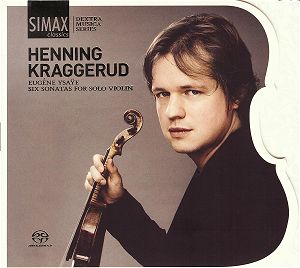The link between
J.S. Bach’s sonatas and partitas
and Belgian violinist and composer
Eugéne Ysaÿe’s op. 27
is a strong feature of these works.
Direct quotations, such as the reference
to Bach’s second sonata in the Sonata
No.2 are the clearest pointers,
but the symbolism and formal relationships
pointed out and illustrated in Henning
Kraggrud’s own comprehensive booklet
notes leach through just about every
aspect of these works. The Bach
informs and strengthens the individual
qualities of each sonata, while
in no way turning any of them into
lame pastiche. Each of Ysaÿe's
solo sonatas is dedicated to a younger
violinist, those among the outstanding
players of their day. Not only do
they bear dedications to Szigeti,
Thibaud, Enescu, Kreisler, Crickboom
and Quiroga, they also contain numerous
more or less hidden messages for
these interpreters.
Henning Kraggerud’s
playing is sturdy and robust, and
where in live performances I have
heard some players over-romanticising
the more gentle movements, the Amabile
in the Sonata No.1 or
the Malinconia in the Sonata
No.2 for instance, Kraggerud
allows the music to speak directly,
giving it plenty of tenderness but
never slackening in intensity or
rhythmic direction. His technical
assurance is second to none, and
the most demanding passages are
breathtaking. I won’t say he makes
them sound easy – the sheer physical
requirements come over like hard-won
battles. Kraggerud always wins however,
giving enough detailed care to allow
the music to shine through, and
showing enough bravura to make the
most important dramatic moments
sound as if the world’s axis is
turning around the hairs of his
bow. The effects and colours in
Les Furies from the Sonata
No.2 crackle and spark with
all the sense of danger you get
from an overhead power cable. Kraggerud
brings out the ‘character’ nature
of the pieces as much as possible,
but it takes an educated ear to
spot many of the clues. Some of
the more apparent of these are to
be found in the ‘Kreisler’-orientated
Sonata No.4, in which his
technical style and bravado appear
interwoven through numerous fantastic
moments. The white-heat of
inspiration which saw Ysaÿe
create these works in a short period
during his 66th year
is reflected in Kraggerud’s performance
with utter conviction from beginning
to end.
This SACD hybrid
recording is truly excellent. In
stereo there is a little of what
sounds like channel-hopping now
and again, but when full surround
mode is used you have more of a
3D sense of the violinist moving
around. This must always be a bit
of a nightmare for sound engineers,
especially when editing, but the
production on this disc is superlatively
good. The violin played by Kraggerud
is a 1744 Guarneri, made in the
last year of the master’s life,
and showing the maker having to
resort to local materials. The back
for instance is made from beechwood
as opposed to the more exotic and
commonly used imported maple. The
loan of the instrument and recording
was funded by Dextra Musica, a series
of such recordings of which this
is a part. There are some lovely
close-up photos of the violin throughout
the well designed disc gatefold
and booklet for this release.
There are a number
of recordings of these remarkable
works around now, and the high technical
demands of the music mean there
are very few if any that one could
call weak. Of the complete sets,
Thomas Zehetmair on ECM has to be
one of the top considerations. Then
there is Leonidas Kavakos on Bis
and Frank Peter Zimmermann on EMI
– also both strong contenders in
the market. These performances all
seem to engender a strong following
in those with whom they have come
into contact, and there is no right
or wrong in this. Henning Kraggerud’s
excellent performances with their
value-added SACD recording can be
considered alongside all comers
as one of the very best at the highest
level.
Dominy Clements











